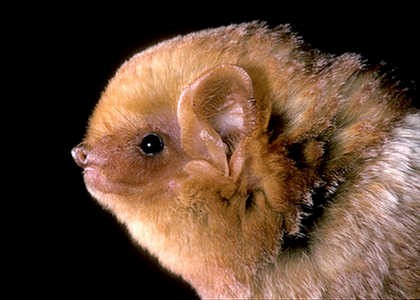When the air turns crisp and pumpkins fill neighborhood porches, it’s time for Bat Week! Bat Week is an annual, international celebration of the role of bats in nature. It’s the last week of October, appropriately leading up to Halloween.
Worldwide, there are more than 1,300 species of bats, and that’s almost 20 percent of all known mammal species. In Virginia, 17 species of bats have been documented. Three of the most common bats in Fairfax County are:
 Big Brown Bat (Eptesicus fuscus)
Big Brown Bat (Eptesicus fuscus)
 Eastern Red Bat (Lasiurus borealis)
Eastern Red Bat (Lasiurus borealis)

Evening Bat (Nycticeius humeralis)
What do all of Virginia’s bats have in common?
- They are a specialized type of carnivore called an insectivore, and they have sharp pointed teeth. Our local bats’ favorite foods include insects such as moths, beetles, wasps, grasshoppers, termites, stinkbugs, dragonflies, mosquitos, ants, flies….the list goes on! Bats annually provide billions of dollars’ worth of free pest-control services by eating tons of insects that harm crops and trees. There is no reason to fear vampire bats here!
- Bats typically bear one young at a time called a pup. Young are born in early summer when temperatures are warmer. Mother bats must continue flying for food when they are pregnant and after giving birth. Baby bats will nurse from their mothers and are not born with fully developed wings or eyesight. Some female bats group together in maternity roosts or colonies and raise their young together. Many dozens or hundreds of bats may use the same tree or structure to reproduce. Locating and protecting maternity colonies is critical to bat conservation.
- Our bats are very small and light, weighing less than one ounce. Tricolored bats (Perimyotis subflavus) are one of our smallest species, weighing just 5-to-8 grams. That’s the weight of a few large paperclips.
- Bats use echolocation to navigate and find prey, but they also have excellent eyesight. Bat calls are ultrasonic, outside of the range of human hearing.
- Bats can live for 20 to 30 years.
- In Virginia, cold weather and a lack of insects forces bats to migrate south or hibernate for the winter. Cave bats are species that hibernate in caves and mines, and tree bats are species that migrate south for the winter and overwinter in trees or leaf litter.
Threatened, Endangered, and Disappearing
Several Virginia native species have seen enormous drops in population. Fairfax County is initiating inventory and monitoring efforts in select parks as part of the Park Authority’s Natural Resource Management Plan. That work will determine the presence of rare or declining bat species. And there are particular species facing serious troubles.
In 2015, the northern long-eared bat was federally listed as a threatened species under the Endangered Species Act. It also is listed as a threatened species under the Virginia Endangered Species Act.
The tri-colored bat is listed as endangered under the Virginia Endangered Species Act.
The little brown bat also is listed as endangered by Virginia. It will not be reviewed under the federal Endangered Species Act until 2023, and some scientists predict the species could be extinct by then. This was an extremely common bat prior to something you may have heard about in news reports — white-nose syndrome.
And therein lies the major problem.
North American bat populations face unprecedented challenges from white-nose syndrome. First discovered during the winter of 2007-2008 in New York, this fungal disease has spread quickly through 29 states and has killed innumerable bats. Bat populations have dropped an estimated 80% or more across the eastern United States, and many bat species that were formerly common are becoming rare. The disease invades the skin of hibernating bats and disrupts their hibernation cycles and their hydration, causing energy depletion and wing damage. It is transmitted from bat to bat inside hibernation areas, such as caves. There’s more information about it at www.whitenosesyndrome.org/.
—
You can help protect bat populations. Volunteering a few hours with the Invasive Management Area program helps protect bat feeding grounds. And parks occasionally hold educational programs and campfires with bats as the topic or theme.
There’s more information at www.batweek.org.
Author Kristen Sinclair is an Ecologist with the Fairfax County Park Authority’s Natural Resources Branch.
